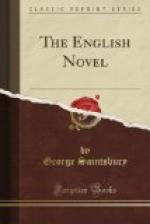It is not uninteresting to compare two such books as Mrs. Bennett’s Anna and Mrs. Opie’s Adeline Mowbray. Published at twenty years’ distance (1785 and 1804) they show the rapid growth of the novel, even during a time when nothing of the first class appeared. Anna, or the Memoirs of a Welsh Heiress, interspersed with Anecdotes of a Nabob, is a kind of bad imitation of Miss Burney, with a catchpenny “interspersion” to suit the day. Adeline Mowbray, written with more talent, chimes in by infusing one of the tones of its day—Godwinian theories of life. The space between was the palmy time of that now almost legendary “Minerva Press” which, as has been said, flooded the ever-absorbent market with stuff of which The Libertine, masterpiece of Mrs. Byrne, alias Charlotte Dacre, alias “Rosa Matilda,” is perhaps best worth singling out from its companions, Hours of Solitude, The Nun of St. Omers, Zofloya, etc., because it specially shocked the censor of the style who will be mentioned presently. It is pure (or not-pure) rubbish. Angelo (the libertine) seduces the angelic Gabrielle de Montmorency, who follows him to Italy in male attire, saves him from the wicked courtesan Oriana and her bravo Fiorenz_a_ (sic), is married by him, but made miserable, and dies. He continues his misbehaviour to their children, and finally blows his brains out. “Bah! it is bosh!” as the Master observes of something else.
It may seem iniquitous to say that some tolerably good novel-writers must be more summarily treated than some bad ones here: but there is reason for it. Such, for instance, as Charlotte Smith and the Miss Lees are miles above such others as the just-mentioned polyonymous “Rosa,” as Sarah Wilkinson, or as Henrietta Mosse-Rouviere. The first three would make a very good group for a twenty-page causerie. Charlotte Smith, who was tolerably expert in verse as well as prose; who anticipated, and perhaps taught, Scott in the double use of the name “Waverley”; and whose Old Manor House (1793) is a solid but not heavy work of its kind—is something of a person in herself, but less of a figure in history, because she neither innovates nor does old things consummately. Harriet and Sophia Lee claimed innovation for the latter’s Recess (1783-1786), as Miss Porter did for Thaddeus of Warsaw, but the claim can be even less allowed. There is nothing of real historical spirit, and very little goodness of any kind, in The Recess. The Canterbury Tales (1797-1805) (so named merely because they are supposed to be told by different persons) were praised by Byron, as he praised the Percy Anecdotes and other things—either irresponsibly or impishly. They are not exactly bad: but also as far as possible from consummateness.




